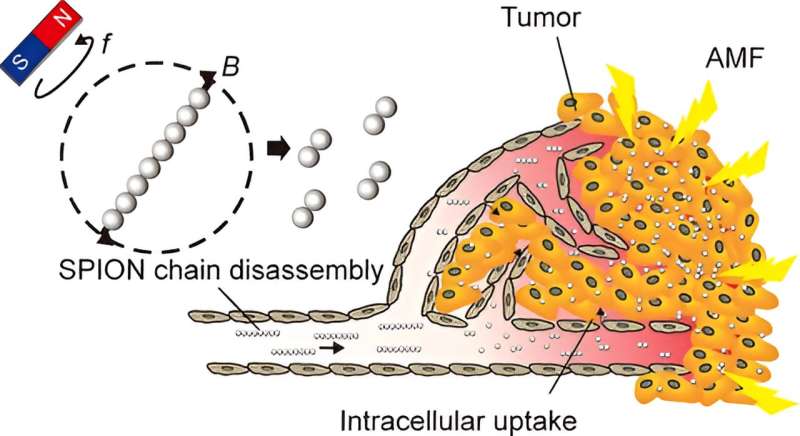This article has been reviewed according to Science X's editorial process and policies. Editors have highlighted the following attributes while ensuring the content's credibility:
fact-checked
peer-reviewed publication
proofread
Team elucidates mechanism for maximizing therapeutic effects of magnetic nanotherapeutics for cancer

A team led by Professor Choi Hong-Soo in the Department of Robotics and Mechatronics Engineering at DGIST has discovered a method to enhance the penetration of magnetic nanoparticles into cancer cells and their magnetic hyperthermia effects through research on chain disassembly and magnetic propulsion mechanisms using a rotational magnetic field.
Published in the journal ACS Nano, their study focused on the delivery of magnetic therapeutic agents using magnetic fields, an area receiving attention in the field of cancer treatment. It is expected to contribute significantly by improving drug delivery efficiency and therapeutic effects in targeted cancer treatments.
Recently, the development of targeted therapeutics that selectively treat cancer cells has been gaining attention in the field of cancer treatment. Among them, research on magnetic carriers that target cancer cells using magnetic fields is underway. However, a problem arises when magnetic nanoparticles are exposed to a uniform magnetic field with a general form; they form long chains in the direction of the magnetic field, making penetration into cancer cells or tumors difficult and reducing the therapeutic efficacy.
In response, the team led by Professor Choi Hong-Soo at DGIST analyzed the interaction between the behavior of magnetic nanoparticles and fluidic viscosity resistance using a unique rotational magnetic field, conducting research on chain disassembly mechanisms that can selectively control magnetic nanoparticle chain lengths.
The research team aimed to verify several factors using a 3D tumor model (tumor spheroids), such as adjusting the length of magnetic nanoparticle chains through a rotational magnetic field, enhanced cellular absorption, and improved magnetic hyperthermia treatment for cancer cells.
First, the team verified the chain disassembly mechanism of magnetic nanoparticles induced by a rotational magnetic field. Targeting cancer cells and tumor spheroids, they induced increased cellular absorption and penetration by driving magnetic nanoparticles with a rotational magnetic field.
Using fluorescence microscopy for intracellular fluorescent magnetic nanoparticle imaging and transmission electron microscopy for cell and spheroid cross-section observation, they proved that the use of a rotational magnetic field led to the deepest penetration of cells and tumor spheroids compared to the comparison groups (those exposed to a uniform magnetic field and those not exposed to any magnetic field).
Moreover, they induced cancer cell destruction using alternating magnetic fields to confirm the magnetic hyperthermia effects of magnetic nanoparticles in each group. The group with the highest penetration rate due to the rotational magnetic field showed the most effective treatment results. This confirmed that the chain disassembly and magnetic propulsion of magnetic nanoparticles through rotational magnetic fields can enhance cellular absorption, penetration, and ultimately, the therapeutic effects of magnetic nanotherapeutics.
Professor Choi Hong-Soo of DGIST stated, "We have verified that magnetic propulsion through rotational magnetic fields aids in the absorption and penetration of magnetic nanoparticles into cancer cells and tumor spheroids, ultimately improving tumor treatment efficacy. We expect that the technology developed through this research can be widely utilized to enhance therapeutic effects in targeted cancer treatment using magnetic therapeutics."
More information: Junhee Choi et al, Magnetically Enhanced Intracellular Uptake of Superparamagnetic Iron Oxide Nanoparticles for Antitumor Therapy, ACS Nano (2023). DOI: 10.1021/acsnano.3c03780
Journal information: ACS Nano
Provided by DGIST





















